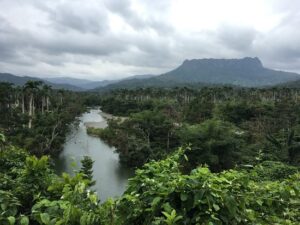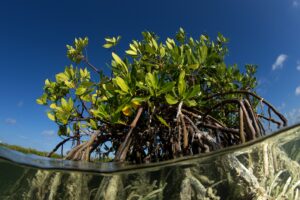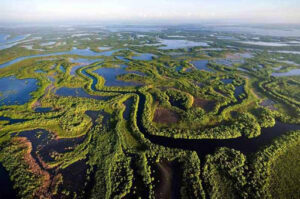Cuba: Enormous potential to join the carbon market

By Daily Pérez Guillén
Cuba will join the carbon markets. The move was approved by the government of the Caribbean country on February 15, through its Council of Ministers. The news was confirmed by the Deputy Minister of Science, Technology and Environment, Rudy Montero, at the agri-food trade forum of the Mano de la Mano Initiative, organized in Havana by the Ministry of Agriculture and the Food and Agriculture Organization of the United Nations (FAO).
This event devoted an important space to this topic as a trade modality that provides financial incentives for the mitigation of climate change, through the contribution of countries to the reduction or elimination of greenhouse gas emissions.
According to statements to TTC by the deputy minister, the move will be carried out “on the basis of prioritized lines in the area of forests, waste, energy and so-called ‘blue carbon.’ The Ministry of Science, Technology and Environment, together with other key institutions and sectors, has the duty to develop a working system that allows Cuba’s insertion in an effective and rational way, based on the Nationally Determined Contribution (NDC) and the country’s existing commitments.”
Montero stressed that the insertion in the carbon market takes into account sustainability criteria. “Regarding this new vision, we will be working on the basis of technical-methodological, scientific and regulatory norms, as well as the conception of business models and concrete projects in the areas of urban solid waste management, energy transition and everything that can be introduced in terms of eliminating pollution generated by industry.”
The deputy minister assured that work is already underway on an enabling framework that will allow the integration of institutions and experts for the rehabilitation of Cuban ecosystems and to make progress in this “challenge for the technical and scientific community.”
As part of the agenda of the agri-food trade forum, Roberta de Souza, a specialist in carbon market financing at FAO, highlighted Cuba’s enormous potential for insertion in this area through REDD+ projects (Reducing Emissions from Deforestation and Forest Degradation).
“Cuba is an exemplary model in the management of its forests, with a negative deforestation rate, which means that it has cultivated more forests in recent years. This unique situation in the world positions the island as a leader in nature-based solutions to combat climate change,” he stressed, while suggesting additional tasks to monetize and finance this work taking into account international cooperation and the support of entities such as FAO to facilitate inclusion in these markets.

A recent press release from the United Nations Development Programme (UNDP) defines carbon markets as trading schemes that provide financial incentives for climate change mitigation, through the contribution of countries to the reduction or removal of greenhouse gas emissions, which are quantified into carbon credits that can be bought and sold, with the aim of transitioning economies to achieve net zero emissions by mid-century.
A carbon credit means one ton of carbon dioxide equivalent has been reduced or removed from the atmosphere and is earmarked for initiatives that guarantee a return in environmental benefits, such as biodiversity protection and energy transition.
World Bank statistics show that there are currently 36 regulated carbon markets existing or being implemented around the world, covering more than 17% of global greenhouse gas (GHG) emissions, which represents an opportunity for countries committed to sustainability.
Cuba currently meets the requirements to participate in the carbon market, after updating its NDC in February 2025, which represents the voluntary commitment of each country to reduce its GHG emissions and adapt to climate change.
According to the document known as the Nationally Determined Contribution 3.0, as one of the ways to achieve the development of a resilient and lower carbon economy, Cuba has identified the use of the cooperative instruments established in Article 6 of the Paris Agreement, mainly related to the implementation of the country’s energy transition program and forestry development.
A brief description contained in the text also specifies that the country, “aims to achieve, according to its National Energy Transition Strategy, a 49.3% share of RES in electricity generation by 2035. Of this, it commits 26% as an unconditional NDC and the rest it plans to devote to the carbon market to invest in RES.”
BLUE CARBON: TREASURE IN CUBAN WATERS

Through a videoconference, FAO Senior Fishery Resources Officer, Kim Friedman, highlighted Cuba’s potential for carbon sequestration in marine-coastal ecosystems.
“Why is aquatic carbon a priority for Cuba?” the expert asked, providing the data for the answer. Cuba’s geographical position, where the Atlantic Ocean, the Caribbean Sea and the Gulf of Mexico meet, endows the country with considerable natural wealth. “Cuba is home to the largest mangrove forest in the Caribbean. Thirty-six percent of all coral reefs with ocean connectivity, showing that its waters are critical to sustaining thriving fisheries, not only within the country, but throughout the Caribbean region and the United States, as Cuban waters provide larvae of key species that help sustain reefs throughout the Caribbean region.”
With a main coastline of more than 1,100 km and nearly 1,600 smaller islands and cays, the archipelago has significant natural capital in terms of blue carbon. “This capital already provides sustainable services to its people, but its value could be leveraged for funds for restoration and maintenance, as well as for blue carbon or carbon as a whole.”
Friedman explained that blue carbon and related assets are emerging markets within international standards that are still in the process of being defined. The UN System recently began formally recognizing wind and wave data within national economic accounting.

“All of these types of accounts are important to a government’s ability to raise revenue. These standards include, on the one hand, internationally recognized procedures for measuring blue carbon, but also methodologies for reporting assets and how markets work,” he explained.
The expert warned that in the Nationally Determined Contributions, planning documents for the United Nations Framework Convention on Climate Change (UNFCCC), marine and inland water habitats are not represented at a very high level. “Coastal and ocean assets are not well recognized compared to action in agriculture and action on carbon in terrestrial systems. However, as we have shown, blue carbon is extremely important for capturing and storing carbon.”
He also highlighted that collectively, blue carbon habitats could account for about 15% of greenhouse gas removals if effective strategies are activated. He noted that the blue carbon credit market is at an early stage, but has great potential, especially when linked to the insurance sector.
“Coastal ecosystems play a crucial role in protecting infrastructure and property from flooding and sea level rise. Nature-based solutions are increasingly being linked to green infrastructure, which offers a different opportunity for revenue generation. There are also synergies with funds aimed at advancing both the UNFCCC and the global framework of the Convention on Biological Diversity and the international Sustainable Development Goals processes,” he said.
“Not only does this action on blue carbon offer monetary benefits and co-benefits, but by protecting and restoring the nature of ecosystems because of the coastal protection value they offer, the insurance sector could become a key player in funding the work we need to do to restore and manage the blue carbon assets in our coastal waters.”
In this regard, he concluded by listing the support actions that FAO can provide in Cuba. To agree on useful harmonized methodologies to measure progress, the Caribbean country needs to inventory its blue carbon assets, its management frameworks, restore them where possible, and work on the blue carbon science and implementation needed.

FAO, meanwhile, could expand and integrate blue carbon stocks and flows into national and international accounting, develop synergies between national agencies and the application of their processes to access funds for coastal management and restoration that have been made available in these international processes, and foster coordination between stakeholders: scientists, government agencies, NGOs and civil society to communicate the co-benefits of protecting, managing and restoring blue carbon ecosystems.
As an example of a case that has gained the attention of investors, he cited the Colombian Vida Manglar project, which has already been certified to sell blue carbon credits under the Verified Carbon Standard.
“We cannot predict the future, but we know that the value of natural resources has defined the success of nations throughout history. Could the next decade see carbon capture become a new source of global wealth?” he asked. “The global focus on climate and biodiversity is mobilizing significant resources through the Green Climate Fund and other financial mechanisms for marine and inland waters. There is a need for greater attention to blue carbon ecosystems, monetizing them and allowing the money they generate to be reinvested in their management and conservation,” he concluded.

MORE NEWS









